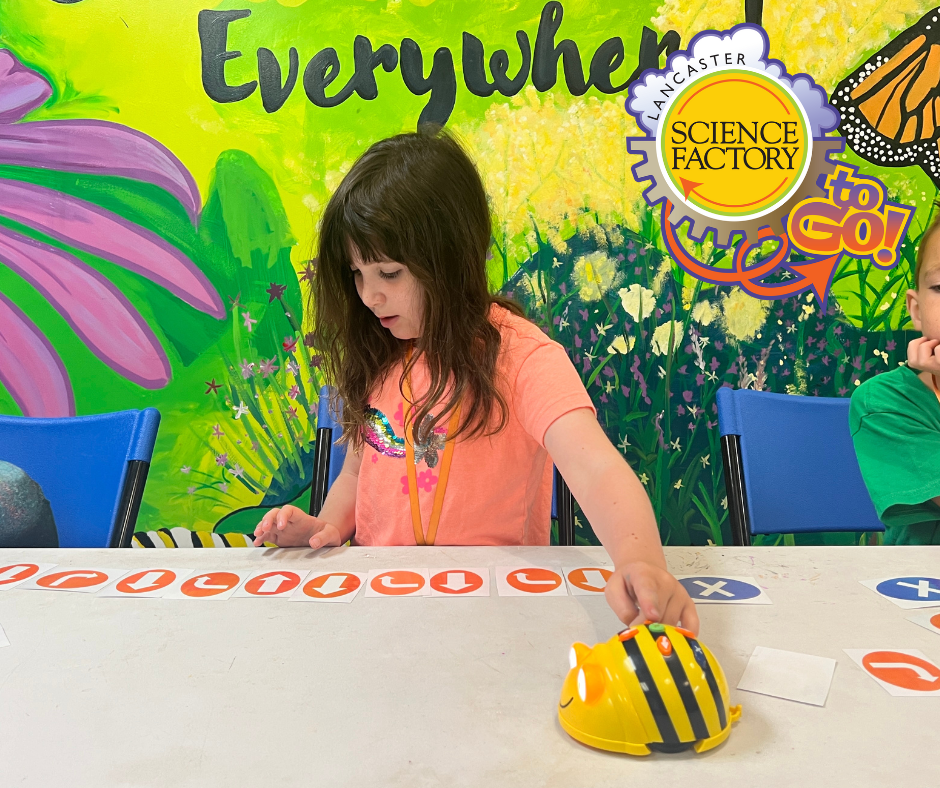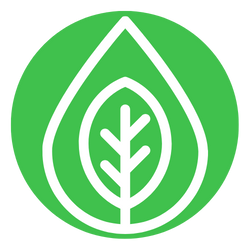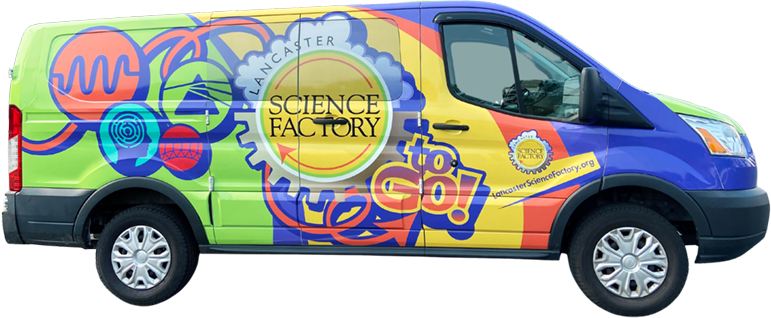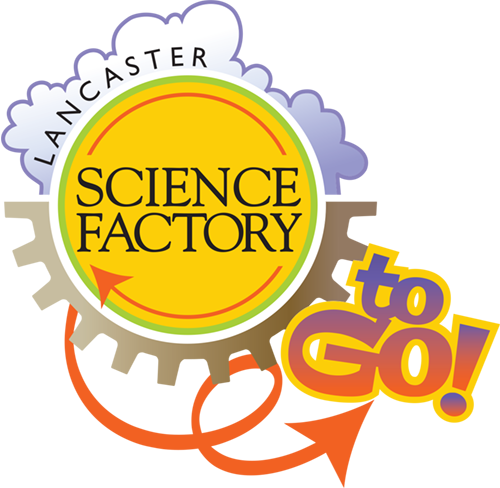Science Factory To Go!
 The Lancaster Science Factory offers a variety of hands-on STEM programs that can be brought to your group in the classroom, library, or almost anywhere!
The Lancaster Science Factory offers a variety of hands-on STEM programs that can be brought to your group in the classroom, library, or almost anywhere!
Each program is aligned with educational standards and is available for grade ranges from K – 8. Choose a single workshop or let you students dive deeper with a series.
Science Factory To Go Pricing
$275 per hour of instruction. Typically 25 – 30 students per workshop. No travel fees! We are currently serving students within 50 miles of Lancaster, PA.
Click here to download the full outreach program menu. OR scroll below the contact form to see a list of workshops!
Want to learn more about bringing the Science Factory To Go to your school or organization? Fill out the request form below to start the conversation!
"*" indicates required fields
Robotics with BeeBots (Grades K – 2) 
In this screen-free robotics session, students explore how robots follow commands by programming a Bee-Bot or Blue-Bot to navigate a simple path. With fun mats and group challenges, learners develop critical early skills, such as sequencing, prediction, and debugging, while learning what makes a robot a robot.
This interactive session introduces:
- The language of robotics (input, command, sequence, debug)
- A playful coding challenge using themed mats or grid maps
- Real-world skills like collaboration, perseverance, and spatial reasoning
Make it a Series:
Through interactive play, storytelling, and movement-based challenges, students explore how robots follow instructions, how to build a sequence, and how to fix a bug when something goes wrong. Each session also includes opportunities for collaborative problem-solving and turn-taking and activities that integrate literacy, math, and spatial reasoning. This series supports early computer science, engineering, and SEL skills, while keeping learning joyful and age-appropriate.
Key Standards Include:
3.5.K-2.X Develop a plan in order to complete a task.
3.5.K-2.A Identify and use everyday symbols.
Robotics with Edison (Grades 3 – 8) 
Meet Edison, the robot you can program with just a scan! In this hands-on robotics session, students explore how robots respond to commands by scanning pre-programmed barcodes that instantly load instructions into Edison.
Students work in teams to explore Edison’s built-in features and test its behaviors in a variety of real-world-inspired challenges. No devices and no downloads, just scan, observe, and engineer solutions.
Make it a Series:
Expand robotics into a series, and students become engineers and programmers as they take control of Edison V3 robots using block-based tools like EdBlocks and EdScratch. Through a progression of hands-on challenges, learners explore how robots sense, decide, and move—while building skills in logic, sequencing, problem-solving, and design.
Each session connects classroom robotics to the way automation works right here in Lancaster County. Students don’t just learn how robots work—they design and test Edison to do useful jobs, then present like professionals. It’s hands-on, Lancaster-connected STEM that turns curiosity into capability and points directly to real careers in our backyard.
Key Standards Include:
3.5.3-5.C Follow directions to complete a technological task.
Observing Light (Grades K – 8)
In this session, students will explore how light interacts with different materials and how shadows are formed and changed. They will experiment with transparent, translucent, and opaque objects, mix colors of light, and observe how light and shadow can create different effects.
Make it a Series (for grades K – 2):
Young scientists will learn just how playful and powerful light can be! In this hands-on series, students explore how light moves, makes shadows, bounces off mirrors, and shines through different materials. Each session includes storytelling, exploration, and guided play to help children observe the behavior of light and describe what they notice. The final session encourages creativity through a “light lab” where students build their own shadow stories using flashlights, puppets, and filters.
Key Standards Include
3.2.1.C Plan and conduct an investigation to determine the effect of placing objects made with different materials in the path of a beam of light.
Make it a Series (for grades 3 – 8):
Light is both art and science—and this series invites students to explore its behavior through hands-on experimentation and design. Students investigate reflection, refraction, and shadow formation using tools such as mirrors, lenses, filters, and laser pointers. They’ll apply their understanding to create kinetic light vignettes: short moving displays that highlight principles of light, such as bending, scattering, and color mixing. This series builds STEM knowledge while sparking creativity and curiosity.
Key Standards Include
3.2.4.F Develop a model to describe that light reflecting from objects and entering the eye allows objects to be seen.
3.2.6-8.R Develop and use a model to describe how waves are reflected, absorbed, or transmitted through various materials
Constellation Creations (Grades K – 2)
Have you ever looked up at the night sky and seen pictures in the stars? In this fun and creative session, students will learn what a constellation is, hear stories about famous constellations like the Big Dipper or Orion, and then create their own star picture!
Using a simple star map, students will connect the stars in new ways and imagine what they see — maybe a dragon, a rocket, or a dancing bear! Then, they’ll draw their constellation and tell a short story about how it ended up in the sky. This session encourages imagination, storytelling, and early science thinking, helping children see patterns and express ideas through art and writing.
Make it a Series:
Dive deeper into the stars! In this series, young learners will become star storytellers. They’ll explore how different cultures — including Greek, Native American, and Maya — saw shapes and characters in the night sky. Students will listen to constellation legends, identify major star patterns, and use simple materials to create their own star stories. They’ll even build a “constellation viewer” to see their stars shine! This series encourages wonder, creativity, and early understanding of astronomy through guided storytelling and hands-on creation.
Key Standards Include
3.3.1.A Use observations of the sun, moon, and stars to describe patterns that can be predicted.
Constellation Creations (Grades 3 – 8)
What pictures do you see in the stars? Students explore the ancient art of constellation-making by connecting dots across the sky. After a brief introduction to real star patterns and myths from cultures around the world, students will use their creativity to design an original constellation and craft a short origin story to explain it. This session blends astronomy with storytelling, helping students connect science and imagination while exploring how humans across history made sense of the night sky.
Make it a Series:
In this interdisciplinary series, students will explore how humans throughout time and across cultures have utilized the stars for storytelling, navigation, and meaning. Through mythology and cultural astronomy, students explore constellations from diverse traditions, including those of the Greek and Maya cultures. Then they’ll take on the role of astronomers and artists to design their own constellation, write an origin myth, and examine how light pollution makes stargazing harder in modern life. The series culminates with a collaborative project-based solution to reclaim the night sky.
Key Standards Include
3.3.6-8.C Analyze and interpret data to determine scale properties of objects in the solar system.
Structural Engineering (Grades 3 – 8)
Students will become structural engineers! They’ll be introduced to different types of bridges and how engineers have designed bridges for specific functions. Working in teams, they’ll they’ll be challenged to build a truss bridge out of craft sticks that can carry a load.
Make it a Series:
Students become junior structural engineers and explore engineering careers in this in-depth series. They will learn how blueprints communicate designs, and build and test different types of bridges. Using KEVA planks for quick modeling and craft-stick trusses with zip ties, teams investigate why triangles make structures strong and how to design for loads and spans.
Key Standards Include:
3.5.6-8.T Create solutions to problems by identifying and applying human factors in design.
3.5.3-5.U Evaluate designs based on criteria, constraints, and standards.
Forces at Play (Grades 3 – 8)
Experience physics you can feel! Why does a balloon rocket zoom forward when the air rushes out the back? In this action-packed outreach session, students explore Newton’s Third Law of Motion: for every action, there is an equal and opposite reaction, by building and testing their own balloon-powered rocket systems.
Make it a Series:
Each session of this series builds upon the last, reinforcing Newtonian concepts through student-led experiments that incorporate real data collection and system modeling. They’ll try demos like the coin trick, tablecloth pull, and balloon rockets. and then expand on them with challenges, such as “make the safest rocket” or “slow the collision.” Crosscutting themes include cause and effect, systems thinking, and data interpretation. Whether your learners are new to physics or ready to design and analyze, this series brings Newton’s laws off the page and into the room.
Key Standards Include:
3.2.3.A Make and communicate observations and/or measurements of an object’s motion to provide evidence that a pattern can be used to predict future.
3.2.6-8.G Apply Newton’s Third Law to design a solution to a problem involving the motion of two colliding objects.
Environmental Engineering (Grades 3 – 8)
in this hands-on experience, students will construct a mini model of a community to investigate what happens to rainwater after it falls. By experimenting with natural and developed surfaces, learners observe how rain moves, where it goes, and how our everyday landscapes affect stormwater runoff. Students will test solutions, such as adding sponges or raising terrain, to see how communities can reduce flooding and protect our waterways. This 60-minute exploration turns students into environmental engineers as they explore how to “slow the flow.”
Make it a Series:
In this series, students become water scientists and city planners. Through hands-on engineering experiments, students simulate rain falling on natural landscapes and developed communities to see firsthand how stormwater behaves. Using data collection, graphing, and problem-solving, they analyze runoff and infiltration in different scenarios. Students apply their knowledge to design green infrastructure solutions like rain gardens, permeable pavement, and bioswales. By the end of the series, students will have developed a blueprint for a greener, more resilient community—one that balances development with healthy water systems.
Key Standards Include
3.3.5.F Generate and design possible solutions to a current environmental issue, threat, or concern.
3.3.6-8.M Apply scientific principles to design a method for monitoring and minimizing human impact on the environment.
Powered Up (Grades 3 – 8)
Students become electrical engineers as they explore how electricity powers everyday devices. Using Snap Circuits® kits, learners construct a simple circuit that lights a lamp or spins a motor and investigate how switches, resistors, and batteries all play a role in the system. This interactive lesson introduces core concepts of electric current and circuit design. Students will make observations, test their builds, and troubleshoot problems just like real engineers. The visit concludes with a team challenge: can you design a circuit that triggers both light and sound?
Make it a Series:
What makes a light bulb glow, a motor spin, or a melody play? In this interactive outreach series, students explore the building blocks of electrical engineering using Snap Circuits®. Learners investigate the core principles of electricity, including current flow, resistance, and circuit design, through a progression of interactive builds from simple to complex.
From lighting up LEDs to designing real-world systems like microgrids and alarms, students develop their scientific reasoning and engineering problem-solving skills with every session. Each visit builds on the last, offering scaffolded challenges that spark creativity and deepen understanding of circuits as systems.
This program aligns with Next Generation Science Standards (NGSS), emphasizing energy transfer, engineering design, and real-world problem solving.
Key Standards Include:
3.2.4.B Make and communicate observations to provide evidence that energy can be transferred from place to place by sound, light, heat, and electric currents.
3.2.4.D Apply scientific ideas to design, test, and refine a device that converts energy from one form to another.
3.5.6-8.K Use devices to control technological systems.
3.5.6-8.GG Create an open-loop system that has no feedback path and requires human intervention.
3.5.6-8.HH Create a closed-loop system that has a feedback path and requires no human intervention.




